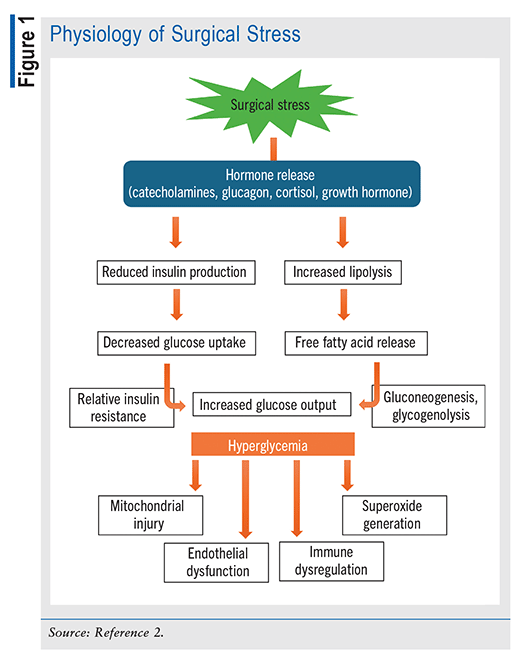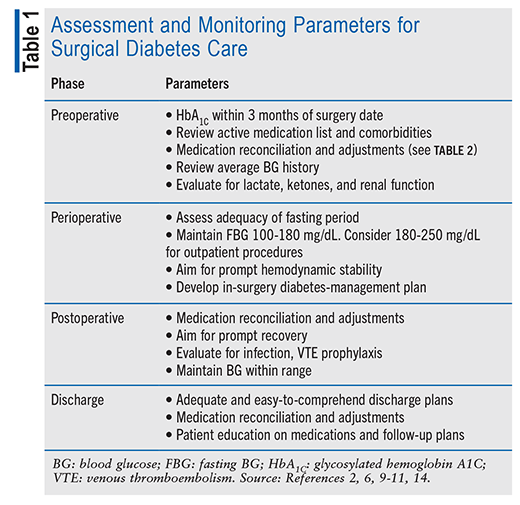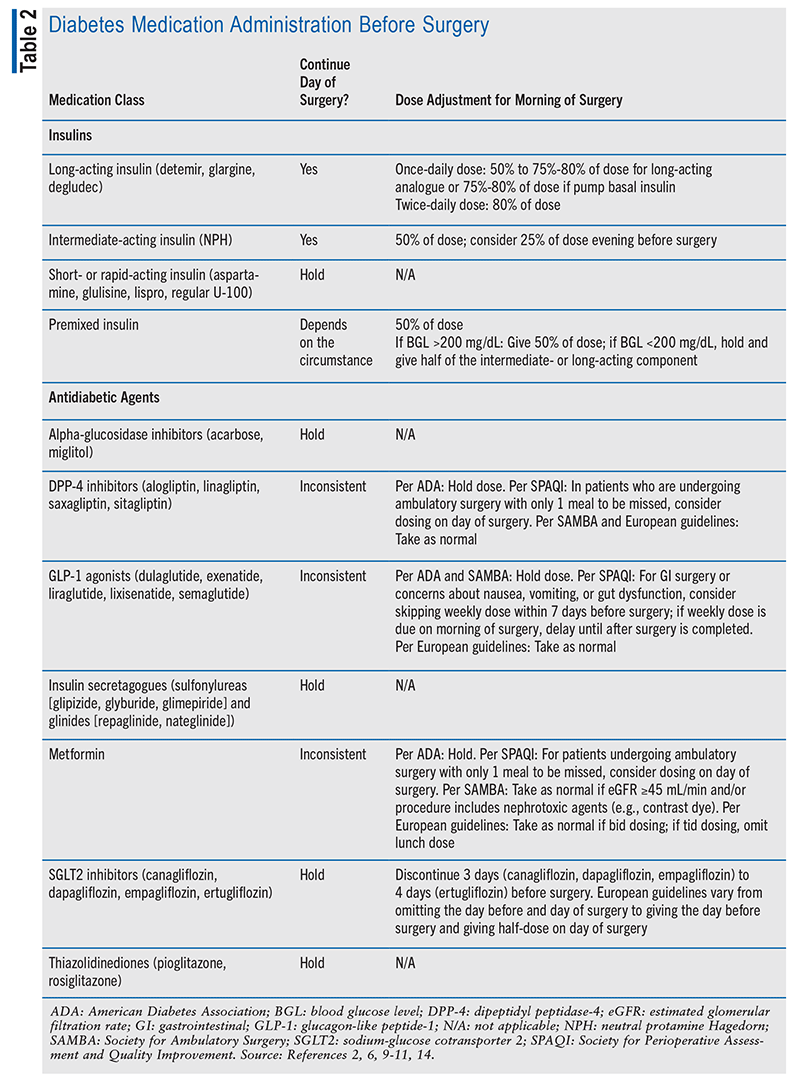US Pharm. 2024;49(11):HS1-HS10.
ABSTRACT: Effective management of patients with diabetes who are undergoing surgery is crucial for minimizing complications and improving outcomes. Clinical pharmacists play a key role in managing glycemic control during surgery and addressing the challenges posed by stress-induced hyperglycemia. Strategies for optimizing medication management include preoperative evaluations, insulin therapy, and careful monitoring of oral diabetes medications. Comprehensive preoperative assessments and structured postoperative care are essential, highlighting the value of expanding pharmacist-led initiatives in diabetic surgical management.
Diabetes is an independent risk factor for poor postoperative outcomes. Effective management of diabetes patients undergoing surgery is crucial for minimizing complications and improving outcomes. Clinical pharmacists play a vital role in managing glycemic control during surgery and addressing challenges posed by stress-induced hyperglycemia.
Surgical Stress
When the body experiences stress, whether physical (surgery, trauma) or psychological (anxiety, fear), cortisol and catecholamines are released. This leads to a reduction in insulin secretion and an increase in glucagon release, stimulating the liver to break down stored glycogen into glucose (glycogenolysis) and synthesize new glucose molecules from noncarbohydrate sources such as amino acids (gluconeogenesis).1,2 This process increases circulating glucose levels, providing immediate energy to cells under stress. In addition, cortisol increases hepatic glucose production, which in turn elevates blood glucose (BG) levels (BGL). See FIGURE 1 (available at www.uspharmacist.com) for a schematic. The development of hyperglycemia triggers the production of reactive oxygen species and raises inflammatory cytokines, which further decreases insulin sensitivity and increases glucagon and growth hormone secretion.

The body’s counterregulatory response intensifies with the severity of surgery and the type of anesthesia used. Factors such as the anatomical site, procedure invasiveness, and intraoperative fluid management contribute to elevated BGL and the duration of stress-induced hyperglycemia.1,2 Surgery involving the chest and abdomen causes more significant and prolonged hyperglycemia than surgery involving the body surface (e.g., biopsy, skin lesion removal). Patients who undergo laparoscopic surgery have a lower incidence of insulin resistance and hyperglycemia compared with those undergoing open surgery. The choice of anesthesia also affects the hyperglycemic response, with general anesthesia more commonly leading to hyperglycemia and higher levels of catecholamines, cortisol, and glucagon compared with regional, local, or epidural anesthesia.1,2
Diabetes is an independent risk factor for poor postoperative outcomes. For cardiac surgery, the mortality rate for patients with diabetes has been reported to be twice as high as for those without diabetes.3 Additionally, perioperative hyperglycemia has been associated with increased risks of ischemic events, arrhythmias, stroke, acute kidney injury, and surgical-site infections.3 In a study of >7,000 mixed surgery patients, those with diabetes had significantly higher odds of mortality at 6 months after surgery compared with those without diabetes (9% vs. 6%, P = .014).4 Patients with diabetes also faced statistically higher rates of major complications, ICU admission, and mechanical ventilation.4 Each 1% increase in glycosylated hemoglobin A1C (HbA1C) was linked to higher rates of complications and longer hospital stays.4 Moreover, in a recent study, patients with diabetes had fewer days at home alive after major noncardiac surgery, signifying higher mortality and readmission rates.5 These findings emphasize the need for targeted perioperative management and preoperative glycemic control to improve patient outcomes and reduce the overall healthcare burden.
Preoperative Assessment
Medical History: The preoperative assessment of patients with diabetes requires a comprehensive evaluation, including a thorough history and physical examination. Key areas of focus include the type and duration of diabetes, BG control, and the presence of end-organ damage.6 Preoperative blood tests should assess BG control through measurements of HbA1C (if not tested in the past 3 months) and current BGL to evaluate the risk of perioperative hyperglycemia or hypoglycemia.6,7 Although no specific HbA1C threshold mandates surgery cancellation, levels >8% are linked to higher postoperative complications.6 Perioperative BGL (from day of surgery to 3rd postoperative day) are more predictive of surgical complications than preoperative HbA1C levels. Patients with BGL >300 mg/dL prior to surgery or symptoms suggestive of diabetic ketoacidosis (DKA) or hyperglycemic hyperosmolar nonketotic syndrome should be considered for postponement and should receive appropriate treatment.2,6,8 See TABLE 1 for assessment and monitoring parameters.

Patients with diabetes often have additional comorbidities that may complicate their surgical course. Obese patients are at higher risk for difficult intubation because of increased collagen accumulation in joints, leading to impaired neck and mouth mobility.6 Preoperative testing should include appropriate cardiovascular evaluations, such as electrocardiography and stress testing, based on the patient’s risk profile and the planned surgical procedure.6,8 The presence of gastroparesis increases the risk of regurgitation and pulmonary aspiration during anesthesia. Additionally, renal function should be assessed preoperatively given the increased risk of renal disease in diabetic patients. Peripheral neuropathy must also be identified to guide anesthesia management and positioning during surgery. These preoperative evaluations are critical for optimizing patient outcomes and minimizing perioperative risks.6
Noninsulin Medications: The use of oral antihyperglycemic and noninsulin injectable medications necessitates important considerations in the perioperative setting. Metformin, for instance, may increase the risk of lactic acidosis, particularly in patients with renal dysfunction and those receiving IV contrast.6,9-11 Sulfonylureas and other insulin secretagogues carry a heightened risk of hypoglycemia. Dipeptidyl peptidase-4 inhibitors may also lower BG, but their use is generally considered to carry a lower risk of hypoglycemia compared with sulfonylureas. Sodium-glucose cotransporter 2 (SGLT2) inhibitors are associated with the risk of euglycemic ketoacidosis, particularly in fasting or acutely ill patients. Additionally, glucagon-like peptide-1 (GLP-1) receptor agonists can exacerbate nausea and vomiting by delaying gastric emptying.
Most oral antidiabetic medications, including metformin, GLP-1 receptor agonists, sulfonylureas, and thiazolidinediones, can be continued preoperatively but should be withheld on the day of surgery.6,9-12 However, SGLT2 inhibitors should be withheld >3 days before surgery and ertugliflozin should be withheld >4 days before surgery.6,7,9,13 An elective surgical procedure generally does not need to be canceled or postponed if a patient accidentally takes oral antidiabetic medications on the day of surgery. Postponement or cancellation of surgery may be considered, however, if the patient has taken an SGLT2 inhibitor or sulfonylurea because of the risks of euglycemic ketoacidosis or hypoglycemia.6
Insulin: Factors to consider in preoperative insulin management include insulin type, dosing frequency, morning BGL, and scheduled surgery time. The management of insulin varies by type and administration method.9,11,14 TABLE 2 highlights the management of insulin and antidiabetic medications before surgery.

Perioperative Management
Perioperative management involves the time period comprising the day of surgery until the 3rd postoperative day. An HbA1C target of <8% for elective surgery and perioperative BGL maintained between 100 mg/dL and 180 mg/dL within 4 hours of surgery are generally recommended.2,6,9 However, optimal targets may vary, as BGL between 180 mg/dL and 250 mg/dL may be appropriate for ambulatory surgery.10 Insulin doses should be adjusted according to the patient’s diabetes type, duration of surgery, and clinical judgment.9 In addition, given the osmolar effects of glucose, fluids and electrolytes should be managed carefully to prevent metabolic complications such as DKA.6
Effective insulin management during surgery is crucial for maintaining optimal BGL and minimizing perioperative complications. For critically ill patients, IV insulin is recommended because its short half-life allows for precise titration and rapid adjustments based on the patient’s fluctuating needs during surgery.1,9 For non–critically ill patients, subcutaneous rapid-acting insulin analogues are preferred, especially for shorter procedures, owing to their ease of administration and lower risk of hypoglycemia.9,10 BG should be monitored every 2 to 4 hours during surgery, with insulin dosing adjusted as required to maintain stable glucose levels.9,10 This approach emphasizes the need for tailored insulin management during surgery that depends on the patient’s individual insulin response and the complexity of the surgical procedure. For diabetic patients using continuous glucose monitoring (CGM) before surgery, it is important to note that CGM devices have not been thoroughly evaluated for intraoperative accuracy, and factors such as hypotension, hypothermia, hypoxia, and electrical interference may affect their reliability.6,9
The choice of anesthesia affects glucose levels. Neuraxial techniques such as spinal anesthesia often provide better glycemic control than general anesthesia, which can worsen hyperglycemia and increase postoperative complications.6,12,15 Regional anesthesia (e.g., spinal, epidural) is preferred for its ability to reduce hyperglycemia, opioid use, and nausea and to improve early mobilization; however, it requires careful consideration because of risks such as longer block duration and potential neuropathy, especially in diabetic patients.12,15 Continuous catheter techniques for prolonged regional anesthesia increase the infection risk, necessitating careful monitoring and aseptic practices. Despite these risks, regional anesthesia is generally favored for its benefits in managing glucose levels during surgery.
An additional consideration is the administration of adjuvant antiemetic medications in the perioperative setting for postoperative nausea and vomiting (PONV). Compared with dexamethasone dosed at 4 mg to 5 mg, doses of 8 mg to 10 mg were associated with a 25-mg/dL greater increase in BG during the perioperative period.2,14
Postoperative Management
Post surgery, the focus should be on preventing hypoglycemia and maintaining stable glycemic control as the patient resumes his or her diet and medication regimen. Patients should be closely monitored as to whether they are able to tolerate enteral intake as well as whether they experience severe PONV, which may increase their risk for hypoglycemia. Transitioning to targeted glycemic management is critical for avoiding infections and complications from hyperglycemia.2,6,9 It is also important to prevent hyperglycemia and related complications, including prolonged hospital stays, and to consider venous thromboembolism prophylaxis, especially in patients on hormonal therapies.10 BGL should be closely monitored during the transition from insulin to home medications to prevent hypoglycemia or rebound hyperglycemia. Additionally, patient education on medication interactions, especially with corticosteroids, should be provided.
Postoperative care for patients with diabetes also involves close monitoring of electrolytes and fluid balance, as osmolar effects of glucose can result in electrolyte imbalances.6 Adjustments to fluid and electrolyte therapy should be made based on the patient’s condition and BGL. This comprehensive approach helps ensure a smoother recovery and minimizes complications in diabetic patients undergoing surgery.
Guidelines
Available guidelines for perioperative diabetes management show variations, with the American Diabetes Association providing brief and focused recommendations, the Society for Perioperative Assessment and Quality Improvement offering guidance on perioperative medication management, and the Society for Ambulatory Anesthesia specifically addressing ambulatory surgery.9-11 European guidelines often present slightly different recommendations.14,16 These variations underscore the need for more robust, evidence-based guidelines that can be universally applied to improve outcomes and standardize care across different regions. TABLE 2 provides a summary of medication and insulin use highlighting these recommendations.
Pharmacist Involvement
Perioperative clinical pharmacists play a crucial part in optimizing medication management and improving patient outcomes throughout the surgical process. They contribute to preoperative medication optimization, intraoperative pharmacotherapy management, and postoperative care transitions.17 Pharmacist involvement enhances safety, reduces complications, and supports better clinical and economic outcomes through interventions such as enhanced recovery pathways, antimicrobial prophylaxis, and glycemic control.
Clinical pharmacists also have a key role in managing BG in patients with type 2 diabetes using informatized glucose management systems. A recent study demonstrated that pharmacist-managed patients had better preoperative glucose compliance, shorter waiting times, reduced hospital stays, and fewer hyperglycemic and hypoglycemic events than those with standard care.18 Additionally, a pharmacist-driven model for postoperative glucose management in colorectal surgery showed lower mean BGL, fewer hyperglycemic events, and more readings within the target range compared with standard care.19 Pharmacists also have a significant impact on preoperative assessments, as seen in pre–bariatric surgery settings wherein patients valued their guidance on medication adjustments and vitamin supplementation.20
Conclusion
Effective diabetes management is critically important for patients undergoing surgical procedures, particularly those with uncontrolled type 2 diabetes. This approach, encompassing preprocedural glycemic control, inpatient diabetes-management services, and structured postdischarge follow-up, is essential to mitigate the increased risks of hospitalization, morbidity, and mortality that are associated with diabetes-related complications. These comprehensive strategies not only enhance patient outcomes but also contribute to reduced hospital stays and minimized healthcare utilization post surgery, highlighting the value of expanding pharmacist-led initiatives in diabetic surgical management.
REFERENCES
1. Duggan EW, Carlson K, Umpierrez GE. Perioperative hyperglycemia management: an update. Anesthesiology. 2017;126(3):547-560.
2. Duggan E, Chen Y. Glycemic management in the operating room: screening, monitoring, oral hypoglycemics, and insulin therapy. Curr Diab Rep. 2019;19(11):134.
3. Thongsuk Y, Hwang NC. Perioperative glycemic management in cardiac surgery: a narrative review. J Cardiothorac Vasc Anesth. 2024;38(1):248-267.
4. Yong PH, Weinberg L, Torkamani N, et al. The presence of diabetes and higher HbA1C are independently associated with adverse outcomes after surgery. Diabetes Care. 2018;41(6):1172-1179.
5. Habermann A, Widaeus M, Soltani N, et al. Days at home alive after major surgery in patients with and without diabetes: an observational cohort study. Perioper Med (Lond). 2024;13(1):4.
6. Galway U, Chahar P, Schmidt MT, et al. Perioperative challenges in management of diabetic patients undergoing non-cardiac surgery. World J Diabetes. 2021;12(8):1255-1266.
7. Dogra P, Anastasopoulou C, Jialal I. Diabetic perioperative management. In: StatPearls [Internet]. Treasure Island, FL: StatPearls Publishing; 2024 Jan-.
8. Fleisher LA, Fleischmann KE, Auerbach AD, et al. 2014 ACC/AHA guideline on perioperative cardiovascular evaluation and management of patients undergoing noncardiac surgery: a report of the American College of Cardiology/American Heart Association Task Force on Practice Guidelines. Circulation. 2014;130(24):e278-e333.
9. American Diabetes Association Professional Practice Committee. 16. Diabetes care in the hospital: Standards of Care in Diabetes—2024. Diabetes Care. 2024;47(Suppl 1):s295-s306.
10. Pfeifer KJ, Selzer A, Mendez CE, et al. Preoperative management of endocrine, hormonal, and urologic medications: Society for Perioperative Assessment and Quality Improvement (SPAQI) consensus statement. Mayo Clin Proc. 2021;96(6):1655-1669.
11. Rajan N, Duggan EW, Abdelmalak BB, et al. Society for Ambulatory Anesthesia updated consensus statement on perioperative blood glucose management in adult patients with diabetes mellitus undergoing ambulatory surgery. Anesth Analg. 2024;139(3):459-477.
12. Levy N, Lirk P. Regional anaesthesia in patients with diabetes. Anaesthesia. 2021;76(Suppl 1):127-135.
13. FDA. FDA revises labels of SGLT2 inhibitors for diabetes to include warnings about too much acid in the blood and serious urinary tract infections. www.fda.gov/drugs/drug-safety-and-availability/fda-revises-labels-sglt2-inhibitors-diabetes-include-warnings-about-too-much-acid-blood-and-serious. Accessed August 7, 2024.
14. Crowley K, Scanaill PO, Hermanides J, Buggy DJ. Current practice in the perioperative management of patients with diabetes mellitus: a narrative review. Br J Anaesth. 2023;131(2):242-252.
15. Mehta PB, Robinson A, Burkhardt D, Rushakoff RJ. Inpatient perioperative euglycemic diabetic ketoacidosis due to sodium-glucose cotransporter-2 inhibitors—lessons from a case series and strategies to decrease incidence. Endocr Pract. 2022;28(9):884-888.
16. Polderman JAW, Hermanides J, Hulst AH. Update on the perioperative management of diabetes mellitus. BJA Educ. 2024;24(8):261-269.
17. Patel GP, Hyland SJ, Birrer KL, et al. Perioperative clinical pharmacy practice: responsibilities and scope within the surgical care continuum. J Am Coll Clin Pharm. 2020;3(2):501-519.
18. Song J, Pan X, Chen Y, et al. Evaluation of the effectiveness regarding the participation of pharmacists in perioperative blood glucose management via the iGMS: a pilot RCT. Diabetol Metab Syndr. 2023;15(1):236.
19. Smith NT, Xiong S, Bergquist WJ, et al. Improved postoperative blood glucose control through implementation of clinical pharmacist driven glycemic management model after colorectal surgery. Am J Surg. 2023;225(6):1050-1055.
20. Graham Y, Callejas-Diaz L, Parkin L, et al. Exploring the patient-reported impact of the pharmacist on pre-bariatric surgical assessment. Obes Surg. 2019;29(3):891-902.
The content contained in this article is for informational purposes only. The content is not intended to be a substitute for professional advice. Reliance on any information provided in this article is solely at your own risk.
To comment on this article, contact rdavidson@uspharmacist.com.





